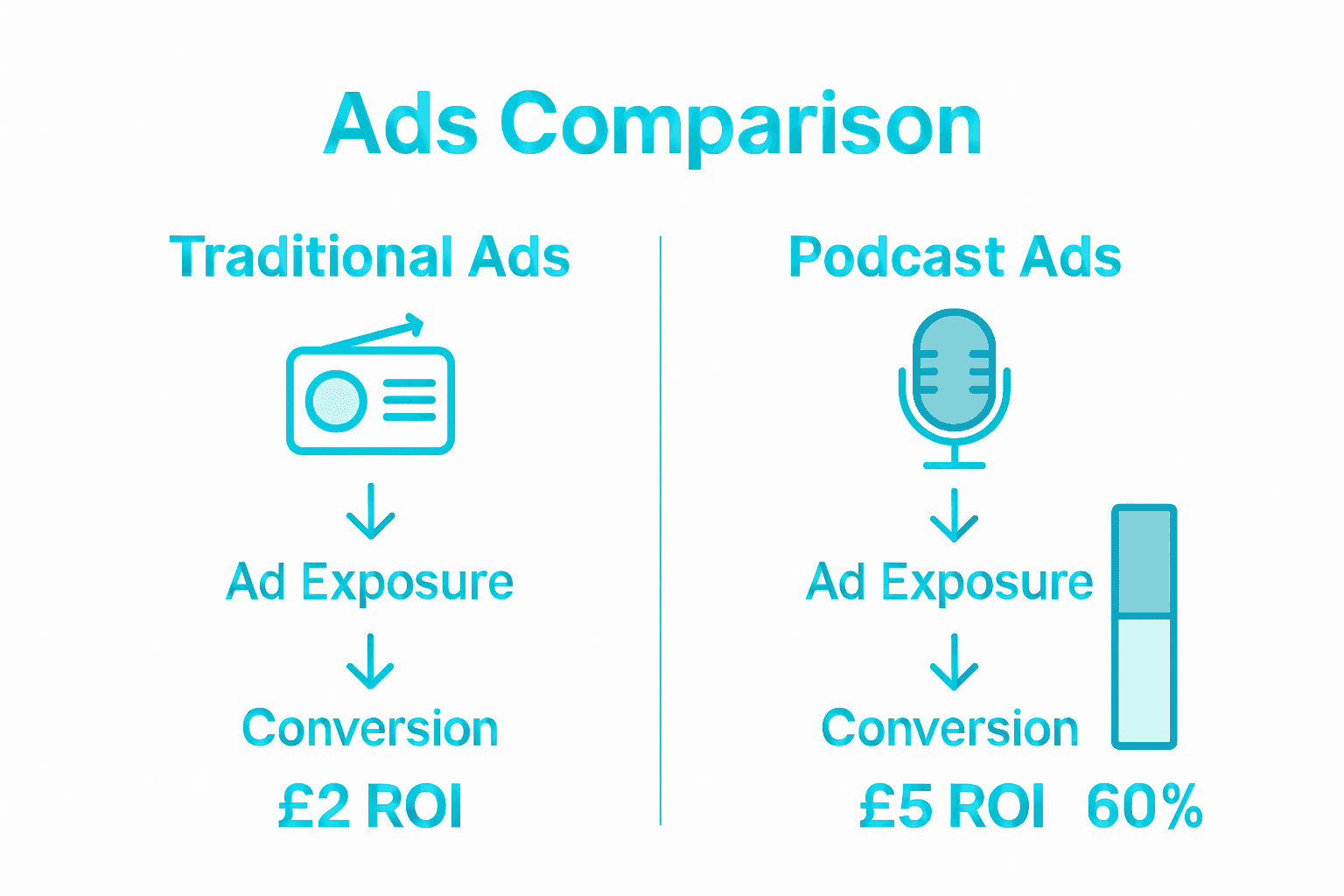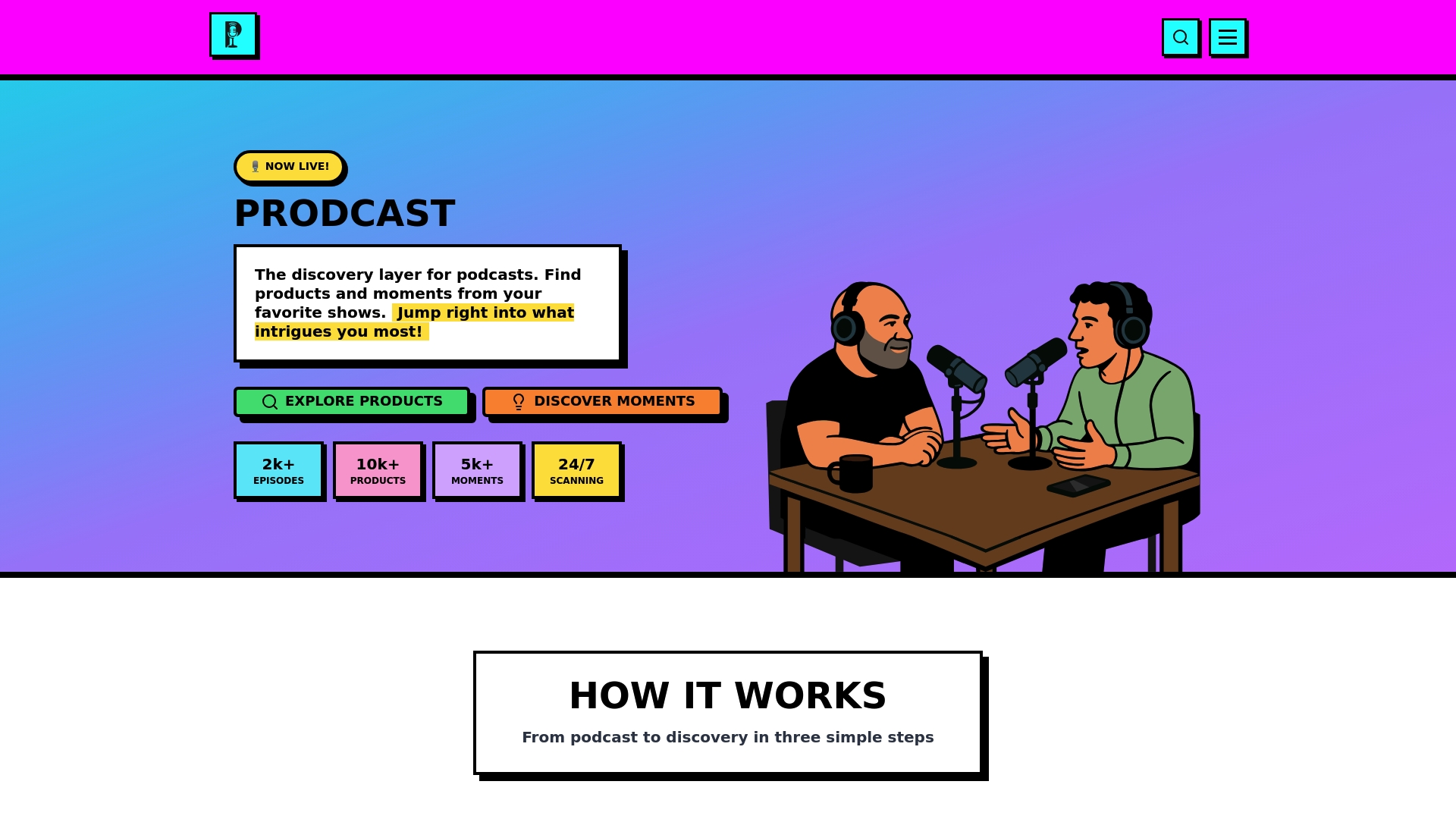CATEGORIES
TAGS
Podcast Advertising ROI: Complete Guide for 2025

Audio marketing delivers more than just buzz—podcast ads can generate over £5 for every pound spent, setting a new standard for return on investment. As streaming shows attract larger, loyal audiences, brands are discovering that podcast advertising can shape real buying decisions in ways traditional ads can’t match. In this guide, you’ll find insights on tracking ROI, measuring the true impact of audio campaigns, and using the latest engagement data to fuel smarter marketing.
Table of Contents
- Defining Podcast Advertising ROI And Impact
- Types Of Podcast Advertising And Measurement Methods
- Key Metrics: Product Mentions And Audience Engagement
- Leveraging Data For Successful Product Discovery
- Challenges, Costs, And Mistakes To Avoid
Key Takeaways
| Point | Details |
|---|---|
| Understanding Podcast ROI | Effective measurement of podcast advertising ROI goes beyond traditional metrics, requiring brands to analyze listener behavior and engagement deeply. |
| Ad Format Importance | Different podcast ad types, including host-read and dynamic insertion, significantly impact listener response and effectiveness. |
| Data-Driven Strategy | Leveraging data for audience targeting and engagement is crucial for successful product discovery through podcasts. |
| Navigating Challenges | Brands must address common pitfalls, such as inadequate audience targeting and poor ad placement, to achieve optimal podcast advertising results. |
Defining Podcast Advertising ROI and Impact
Podcast advertising represents a dynamic and increasingly sophisticated marketing channel where understanding Return on Investment (ROI) goes far beyond traditional metrics. According to radiocentre, audio advertising can deliver an impressive profit return of £5.20 for every pound spent, highlighting its significant potential for brands seeking targeted engagement.
Defining podcast advertising ROI involves tracking multiple critical performance indicators that reveal the genuine impact of audio marketing efforts. tijer emphasizes the importance of measuring conversion rates through specific listener actions such as:
- Website visits
- Newsletter sign-ups
- Direct product purchases
- Promo code redemptions
- Social media engagement
Successful podcast advertising ROI measurement requires a comprehensive approach that combines quantitative data with qualitative insights. Brands must look beyond simple listener numbers and dive deep into audience behavior, understanding how podcast content influences purchasing decisions and brand perception. This means tracking not just immediate conversions, but also long-term brand awareness and customer lifetime value.
With podcast audiences growing exponentially, advertisers need sophisticated tracking mechanisms that can capture the nuanced ways listeners interact with branded content. Contextual relevance becomes key—matching advertisements to podcast themes and audience interests increases the likelihood of meaningful engagement and higher ROI. Modern podcast advertising is no longer about broad reach, but precise, targeted communication that resonates with specific listener segments and drives actionable results.

Types of Podcast Advertising and Measurement Methods
Podcast advertising has evolved into a sophisticated ecosystem with multiple sophisticated ad formats designed to capture listener attention and drive meaningful engagement. Scholarcommons highlights the critical distinction between different ad types, particularly emphasizing the nuanced differences between host-read and announcer-read advertisements.
The primary types of podcast advertising include:
- Host-Read Ads: Personalized endorsements where podcast hosts directly integrate product messaging
- Pre-Roll Ads: Brief promotional spots played before the main content begins
- Mid-Roll Ads: Advertisements strategically placed in the middle of podcast episodes
- Post-Roll Ads: Promotional content aired after the episode concludes
- Dynamic Ad Insertion: Targeted ads programmatically inserted into podcast episodes
Interestingly, Digitalcommons reveals fascinating insights into the psychological complexity of podcast advertising, particularly around humor-based advertising strategies. The research suggests that listener responses can vary dramatically based on the ad’s tone, delivery method, and contextual relevance.
Measurement methods for podcast advertising have become increasingly sophisticated, moving beyond simple download metrics to track more nuanced engagement indicators. Podcast analytics now encompass comprehensive tracking mechanisms that include listener retention rates, ad completion percentages, conversion tracking, and granular audience demographic insights. Successful advertisers leverage these advanced measurement techniques to understand not just reach, but actual listener interaction and response to podcast advertisements.
Key Metrics: Product Mentions and Audience Engagement
Product mentions have become a critical metric in podcast advertising, revealing the profound impact of audio marketing on listener behavior. Marketing reveals a remarkable statistic: 67% of listeners can recall products and brands featured in podcast ads, with an impressive 61% having actually purchased a product or service they first learned about through podcasts.
Key engagement metrics for podcast advertising include:
- Brand Recall: Percentage of listeners who remember product mentions
- Conversion Rate: Number of listeners who take action after hearing an ad
- Search Lift: Online searches triggered by podcast advertisements
- Social Media Interaction: Engagement generated through ad-related content
- Purchase Intent: Listener’s likelihood of buying recommended products
Gitnux highlights another fascinating insight, reporting that 68% of podcast listeners have conducted online searches for products or services after hearing about them in ads. This demonstrates the powerful indirect conversion potential of podcast advertising, where listeners may not immediately purchase but actively seek more information.
To truly understand audience engagement, podcast advertisers need comprehensive tracking strategies that go beyond traditional metrics. Modern measurement approaches now incorporate sophisticated listener tracking, sentiment analysis, and multi-touch attribution models that capture the nuanced journey from initial product mention to eventual conversion.
Leveraging Data for Successful Product Discovery
The landscape of podcast advertising has transformed dramatically, with data-driven strategies becoming the cornerstone of successful product discovery. Gitnux highlights a compelling insight, revealing that 65% of marketers now recognize podcasts as an essential channel for brand strategy, underscoring the critical role of sophisticated data analytics.
Key data leveraging strategies for product discovery include:
- Listener Behavior Tracking: Analyzing audience interaction patterns
- Contextual Ad Placement: Matching products with relevant podcast content
- Sentiment Analysis: Understanding listener reactions and preferences
- Demographic Targeting: Segmenting audiences for precise product recommendations
- Conversion Path Mapping: Tracking listener journey from ad exposure to purchase
Worldmetrics provides further validation, reporting that an impressive 70% of podcast listeners have taken concrete action after hearing a brand mention. This statistic underscores the immense potential of using dynamic podcast ads for product discovery.
Advanced data analytics now enable podcasters and advertisers to move beyond traditional metrics, creating a nuanced understanding of listener preferences. By integrating machine learning algorithms, real-time tracking, and sophisticated audience segmentation, brands can craft hyper-personalized product recommendations that resonate deeply with specific listener demographics and interests.

Challenges, Costs, and Mistakes to Avoid
Podcast advertising requires strategic navigation through complex financial and performance landscapes. Radiocentre provides valuable context, revealing that while audio advertising can produce an impressive £7.70 revenue return for every pound invested, achieving such results demands meticulous planning and avoiding critical missteps.
Common challenges and potential mistakes in podcast advertising include:
- Inadequate Audience Targeting: Failing to match ads with relevant listener demographics
- Poor Ad Placement: Inserting advertisements that disrupt podcast flow
- Insufficient Tracking: Neglecting comprehensive performance measurement
- Inconsistent Messaging: Creating ads that feel disconnected from podcast content
- Budget Misallocation: Overspending without clear conversion strategies
Tijer emphasizes the critical importance of rigorously tracking conversion rates and ROI to prevent resource misallocation. Successful podcast advertisers understand that metrics go beyond simple listener numbers, requiring deep analytical insights into audience behavior and engagement patterns.
Navigating podcast advertising effectively means developing a holistic approach that balances creative storytelling with data-driven precision. Podcast ad optimization requires continuous learning, where brands must remain adaptable, regularly reassess their strategies, and be willing to pivot based on real-time performance data.
Unlock True Podcast Advertising ROI with Real-Time Insights
Understanding the full impact of your podcast ads means moving beyond simple metrics to tracking product mentions, audience engagement, and conversion paths. If you find it challenging to accurately measure how your ads influence listener behavior or want to avoid common pitfalls like poor targeting and inadequate tracking, you are not alone. Podcast advertisers now need sophisticated, data-driven tools that capture every opportunity to boost ROI by aligning ad content with audience interests and purchase intent.
With Prodcast, you can transform this challenge into a competitive advantage. Our AI-powered platform analyzes podcast transcripts to reveal which products and brands are trending, surfacing actionable insights from thousands of shows. Discover exactly what your target audiences are hearing and buying, and leverage this real-time data to optimize ad placements and creative messaging. From tracking product mentions to uncovering game-changing trends across industries, Prodcast bridges the gap between podcast conversations and measurable marketing success.
Take control of your podcast advertising strategy today.

Explore the future of data-driven podcast advertising at Prodcast. Start uncovering insights that turn audience engagement into sales and ensure every ad dollar you spend drives real and lasting returns. Visit Prodcast now and see how intelligent analytics can maximize your podcast advertising ROI.
Frequently Asked Questions
What is podcast advertising ROI, and why is it important?
Podcast advertising ROI refers to the return on investment generated from audio marketing efforts. It’s important because it helps brands understand the effectiveness of their advertising, going beyond simple listener numbers to gauge audience behavior and long-term brand influence.
How can brands measure the success of podcast advertising campaigns?
Brands can measure podcast advertising success by tracking several key metrics, such as conversion rates, website visits, promo code redemptions, brand recall, and audience engagement. Sophisticated tracking mechanisms allow for deeper insights into listener interactions with advertisements.
What are the different types of podcast advertising formats?
The primary types of podcast advertising include host-read ads, pre-roll ads, mid-roll ads, post-roll ads, and dynamic ad insertion. Each format has its unique advantages for capturing listener attention and driving engagement.
What challenges do businesses face when advertising on podcasts?
Businesses often face challenges such as inadequate audience targeting, poor ad placement, insufficient tracking of results, inconsistent messaging, and budget misallocation. Addressing these issues is crucial for optimizing the effectiveness of podcast advertising.